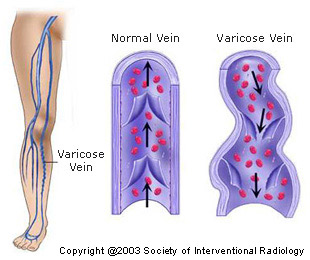What are Varicose Veins?
If you suffer from bulging leg veins, restless legs, pain, discomfort,
swelling, itching or discoloration in your legs, you may be suffering
from varicose veins.
Varicose veins can become very large and in most cases very
painful.
When they become noticable, they are often visible through the
skin and develop a purple to blue color. If the skin over the
varicose vein breaks down, occasionally bleeding occurs from
the thin walled vein.

Other symptoms that varicose veins cause include itching, burning
and aching in the legs. This is worse when you are standing for
several hours during the day.
If the veins are left untreated, the skin overlying the vein
can change color, get harder and ultimately swell and break down.
The earlier you seek treatment, the healthier your legs can be.
Unsightly veins can be broadly divided into
2 categories: Varicose Veins or Spider/Telangiectasia Veins.
Varicose
veins usually are the consequence of valve dysfunction
in a major vein on the inside of the thigh called the Great Saphenous
Vein or in the back of the calf called the Short Saphenous Vein.
The great saphenous vein is only visible using an ultrasound
machine and thus all of our patients with bulging varicose veins
undergo a comprehensive ultrasound test as part of the evaluation
of varicose veins in the legs.
With the ultrasound machine, we
look at the size of the vein and the blood that flows through
it. We can see whether blood is flowing in the wrong direction. If there is, this tells us there has a been a breakdown of one-way valves causing blood leakage in the wrong direction. The blood leaks from
deep veins in the thigh into the calf and pools in the varicose
veins in the leg. This pooling of blood causes the veins to stretch
and become varicose. With time, if left to themselves, these
veins can clot, become infected and lead to breakdown of the
skin causing venous ulcers.
Spider veins are tiny threadlike blue,
purple or red veins that occur all over the leg with or without
the larger varicose type veins. They are a cosmetic issue and
lead to no adverse complications. Sometimes the small spider
veins are associated with deeper problems and so we will still
check with an ultrasound test to see whether your greater and
lesser saphenous veins are normal. Spider veins, as with varicose
veins, are unfortunately a chronic problem and ultimately end
up being a lifelong problem for most patients. Even after successful
treatment, new spider veins will show up in other areas as your
body continues to develop them. As such, most patients need somewhat
regular treatments to keep their legs looking their best.
|


